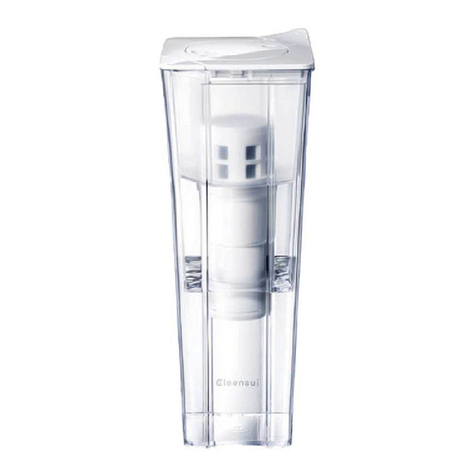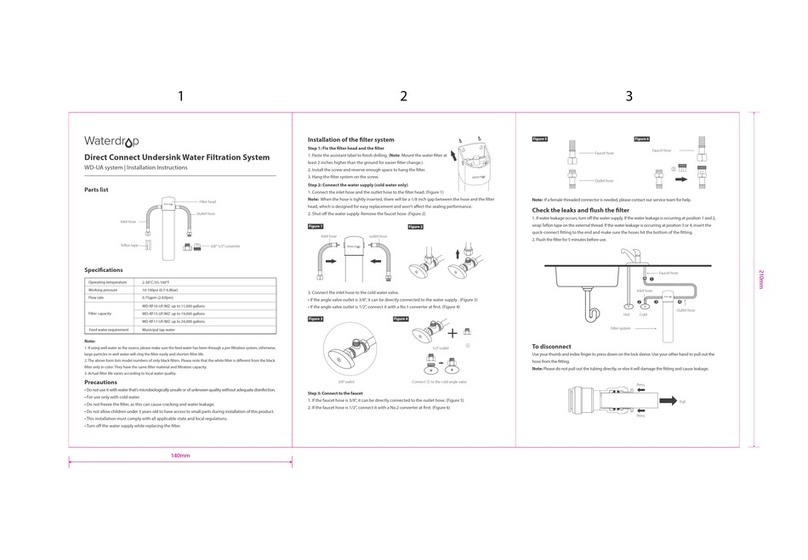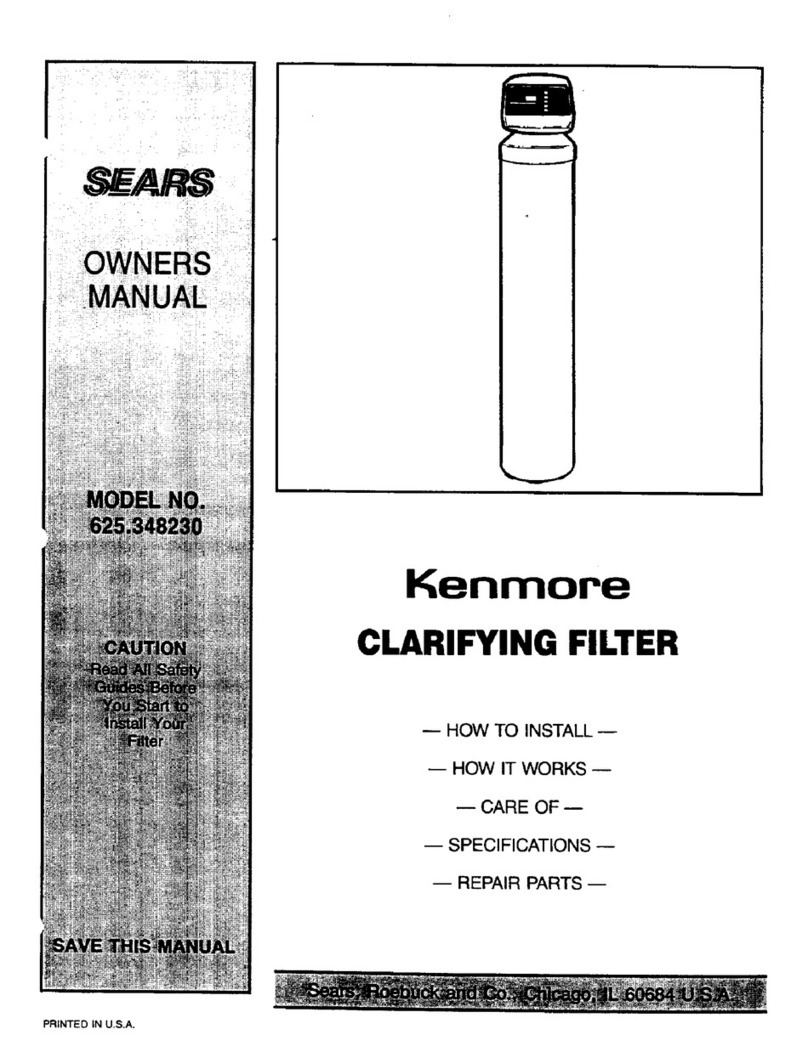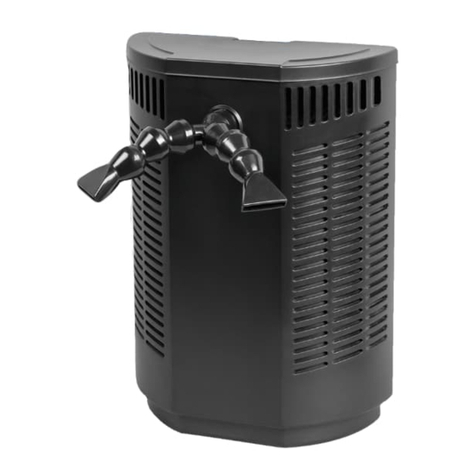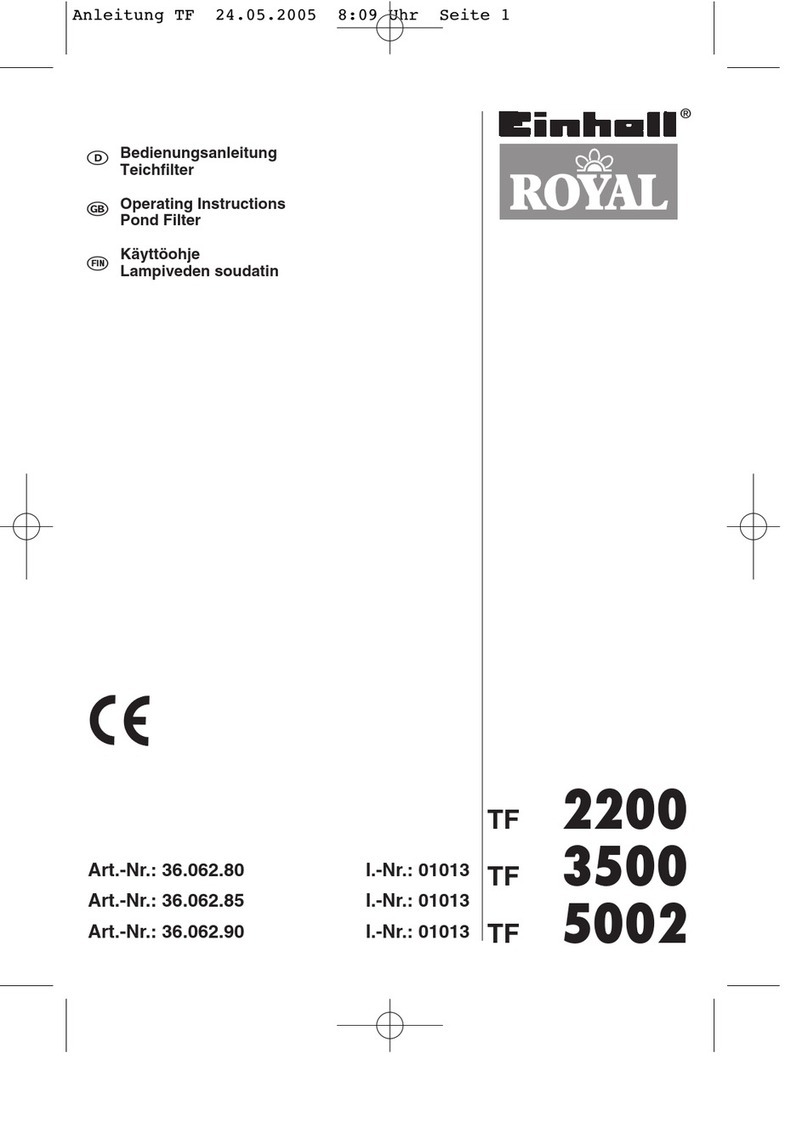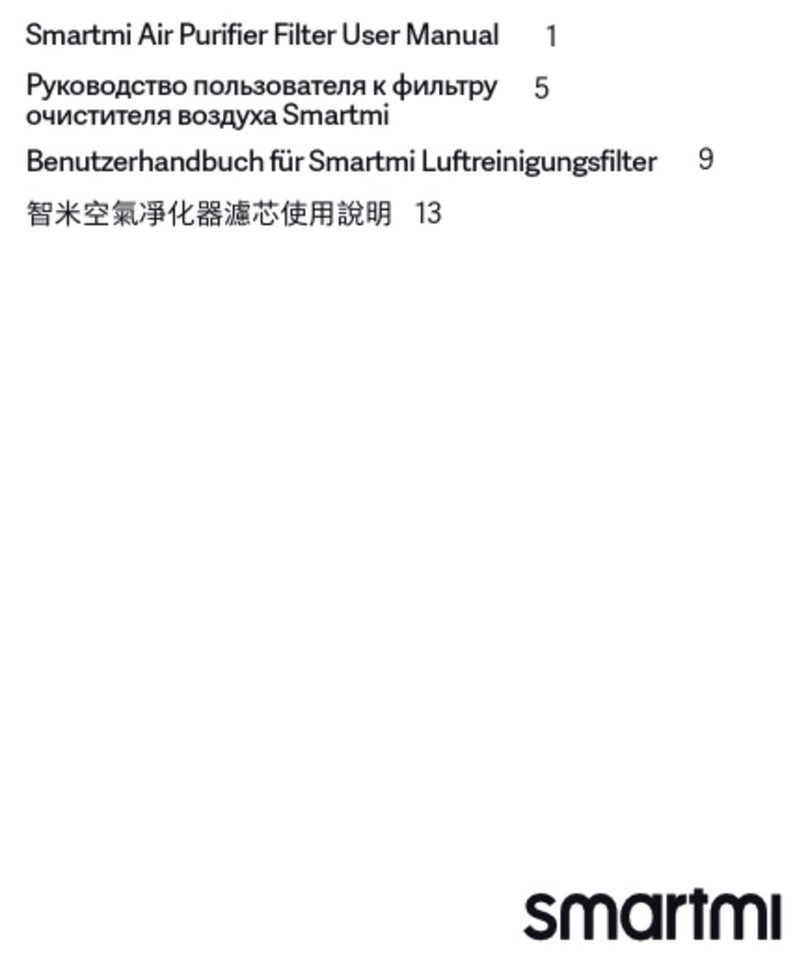Mitsubishi STERAPORE 5700 Series User manual

1st Edition, September 2015 1/58
STERAPORE 5700 Series (FF)
Instruction Manual

STERAPORE 5700 Series (FF) Instruction Manual 2/58
Introduction
This instruction manual describes the outlines, designs, installation, operation,
and maintenance of the STERAPORE 5700 Series (FF).
Please read this manual completely before using this product,
and use the product safely and appropriately.
Keep this manual in a safe place after reading it.
Please confirm the specifications of the products covered by this instruction manual in
[Chapter 10 Specifications].

Table of Contents
STERAPORE 5700 Series (FF) Instruction Manual 3/58
T
Ta
ab
bl
le
e
o
of
f
C
Co
on
nt
te
en
nt
ts
s
CHAPTER 1 MBR COMPOSITION AND PLACEMENT...........................................................6
1-1 OVERVIEW OF MBR.............................................................................................................................. 6
1-2 COMPOSITION OF MBR EQUIPMENT ...................................................................................................... 8
1-3 MBR PLACEMENT............................................................................................................................... 10
CHAPTER 2 FILTRATION AND MEMBRANE SCOUR AERATION.......................................12
2-1 FILTRATION......................................................................................................................................... 12
2-2 MEMBRANE SCOUR AERATION DEVICES............................................................................................... 14
2-3 CLEANING THE DIFFUSER.................................................................................................................... 15
CHAPTER 3 CHEMICAL CLEANING.....................................................................................17
3-1 CHEMICAL CLEANING .......................................................................................................................... 17
3-2 CLEANING EQUIPMENT........................................................................................................................ 25
CHAPTER 4 PRETREATMENT..............................................................................................28
4-1 PRETREATMENT.................................................................................................................................. 28
4-2 ACTIVATED SLUDGE............................................................................................................................. 30
4-3 SUPPLEMENTS.................................................................................................................................... 30
CHAPTER 5 TRANSPORT AND INSTALLATION..................................................................31
5-1 TRANSPORT AND INSTALLATION............................................................................................................ 31
5-2 PROCEDURES FOR LIFTING UP MODULES............................................................................................. 37
CHAPTER 6 OPERATION......................................................................................................39
6-1 COMMISSIONING................................................................................................................................. 39
6-2 OPERATION MANAGEMENT .................................................................................................................. 40
6-3 MBR SYSTEM OPERATION .................................................................................................................. 46
CHAPTER 7 TROUBLESHOOTING.......................................................................................48
7-1 TROUBLESHOOTING:EXAMPLES .......................................................................................................... 48
CHAPTER 8 MAINTENANCE ................................................................................................50
8-1 MEMBRANE REPAIR............................................................................................................................. 50
8-2 DIFFUSER CLEANING........................................................................................................................... 51
8-3 PROCEDURE FOR LONG-TERM STORAGE OF USED MODULES................................................................ 52
CHAPTER 9 REFERENCE MATERIALS ...............................................................................53
9-1 GLOSSARY ......................................................................................................................................... 53
9-2 LIST OF CONSUMABLES....................................................................................................................... 55
9-3 CHEMICAL RESISTANCE OF THE PRODUCT............................................................................................ 55
CHAPTER 10 SPECIFICATIONS.............................................................................................56
10-1 ELEMENT SPECIFICATIONS .................................................................................................................. 56
10-2 MODULE SPECIFICATIONS.................................................................................................................... 57

For Safe Use
STERAPORE 5700 Series (FF) Instruction Manual 4/58
F
Fo
or
r
S
Sa
af
fe
e
U
Us
se
e
This Instruction Manual indicates precautions that must be followed to prevent injury to the user or other
persons, to prevent property damage, and to use the product safely.
These indications and symbols are defined as written below. If you lose or damage this manual, contact the
Membrane Department of the Membrane Division at MITSUBISHI RAYON AQUA SOLUTIONS CO., LTD.
(p.58). You can find contact details on the last page of this manual.
The extent of injuries and damage that will occur if the precautions are ignored and the product is used
incorrectly are indicated as follows.
WARNING
Not following precautions marked with WARNING could lead to death or serious
injury
*
1.
CAUTION
Not following precautions marked with CAUTION could lead to injury
*
2or property
damage
*
3.
*1Serious injury refers to such things as loss of eyesight, injury, high and low temperature burns (burns that occur
when the skin is exposed to a heating element that is hotter than body temperature for a long period of time,
causing symptoms such as red spots (erythema) and blisters), electric shock, fractures, and/or poisoning,
which leave after effects, or require hospitalization or long term treatment at a hospital as an outpatient.
*2Injury refers to injuries, burns, electric shocks and so on that do not require hospitalization or long term
treatment at a hospital as an outpatient.
*3Property damage refers to widespread damage to buildings, household belongings, livestock and/or pets.
Prohibited actions and actions which must be performed are indicated by the following symbols.
These symbols indicate actions that are prohibited.
This symbol indicates actions that must be performed.
Mitsubishi Rayon shall not bear any responsibility for any damage to human lives, property and the like
caused by any systems in which this product is included due to improper use that does not follow this
instruction manual.
This product requires due care and attention when being installed and used. This instruction manual does not
necessarily cover all precautions that need to be followed when installing or using this product.
WARNING
This instruction manual contains descriptions regarding MBR (membrane bioreactor)
treatment of domestic and industrial wastewater, and instructions on using devices. Do not
use it for any other purposes.
Do not drink, or take baths or showers using water directly after it has been treated by this
product.
When handling elements or modules, wear protective clothing and follow construction
company safety standards to prevent industrial accidents.
Be sure to wear protective clothing such as goggles and rubber gloves when handling
chemicals such as sodium hypochlorite (NaClO - used for membrane cleaning) or acid.
If any of these chemicals come into contact with your hands, eyes, or other body parts it may
cause loss of eyesight or chemical burns. In this case, thoroughly rinse the affected part and
consult a doctor.

For Safe Use
STERAPORE 5700 Series (FF) Instruction Manual 5/58
Do not mix sodium hypochlorite (NaClO) and acid under any circumstances. Doing so
releases chlorine gas, which is very dangerous. Be sure to take this into account when
designing the system.
As the modules are very heavy, when using forklifts and cranes make sure that all
apparatus is inspected and certified, and all operators are certified.
CAUTION
Conduct regular inspections and maintenance of the products.
Move modules with care to prevent them from bumping into pipes or other equipment.
When attaching lifting chains or wire ropes to modules, ensure that they are kept taut so
they do not touch the modules.
If the chain or rope touches the upper part of modules, elements will become worn or damaged
due to oscillation caused by aeration.
Use elements with due care to prevent tools, pipes, or other machines from touching the
membrane.
Do not perform construction work that may damage modules, especially membranes, near
the products. Exposure to fire is strictly prohibited.
Sparks from welding or sanding will damage membranes.
Store and transport elements and modules within a temperature range of 5 to 40°C, avoid
direct sunlight, and store them in a dry location.
If elements or modules freeze while they are wet the membrane will be damaged.
Do not treat wastewater which contains organic solvents and/or chemicals that can swell,
damage, or degrade the products.
It causes deformation, damage and malfunction.
Dispose of elements and modules as industrial waste in accordance with laws and local
ordinances.
If there is a danger of chemical leaks that may damage nearby equipment and cause
environmental pollution, be sure to take all necessary measures to prevent chemicals from
splashing or spilling.

Chapter 1 MBR Composition and Placement
STERAPORE 5700 Series (FF) Instruction Manual 6/58
C
Ch
ha
ap
pt
te
er
r
1
1
M
MB
BR
R
C
Co
om
mp
po
os
si
it
ti
io
on
n
a
an
nd
d
P
Pl
la
ac
ce
em
me
en
nt
t
STERAPORE 5700 Series (FF) hollow fiber membrane modules are submerged membrane modules used for
MBR (membrane bioreactor) wastewater treatment. Install the products in a membrane tank and use them for
solid-liquid separation.
1-1 Overview of MBR
In conventional activated sludge processing, solid-liquid separation is performed in a settling tank. However,
in the MBR system it is performed in a membrane module. Consequently, a settling tank for sludge settling is
not required in MBR systems, a high MLSS (mixed liquor suspended solids) concentration can be maintained,
and 100% separation of SS (suspended solids) larger than the membrane pore diameter is possible.
Figure 1-1 shows a schematic diagram of conventional activated sludge processing and MBR.
Figure 1-1 Schematic Diagram of Conventional Activated Sludge Processing and MBR
The differences between the MBR process and the conventional activated sludge process, and the
advantages of MBR are as follows.
As the membrane pore diameter is smaller than bacteria (e.g. colon bacillus), clear, safe treated water can
be obtained. Treated water can be re-used as greywater, or used as raw water for RO (reverse osmosis)
membrane system treatment.
MBR systems are simple and compact, as a final sedimentation tank is not required.
As there is no need to allow sludge to settle, the MLSS concentration level in the aeration tank stays high,
ranging from around 5,000 to 15,000 mg/L. Consequently, the aeration tank is compact.
When inorganic coagulant addition is used for dephosphorization, the phosphate elimination rate can be
significantly improved.

Chapter 1 MBR Composition and Placement
STERAPORE 5700 Series (FF) Instruction Manual 7/58
There are two types of MBR system.
Integrated MBR systems which place membrane modules in aeration tanks.
Separate MBR systems which place membrane modules in separate membrane tanks.
Figure 1-2 shows schematic diagrams for both.
Figure 1-2 Schematic Diagrams of the Integrated MBR System and Separate MBR System

Chapter 1 MBR Composition and Placement
STERAPORE 5700 Series (FF) Instruction Manual 8/58
1-2 Composition of MBR Equipment
The MBR system is composed of various components, including membrane modules, chemical cleaning
equipment, permeate pumps, blowers, etc.
Figure 1-3 shows an example schematic diagram of an MBR system.
Figure 1-3 Schematic Diagram of an MBR System (Example)
1-2-1 Roles of Main Components
and Tanks in the MBR System
①Flow equalization tank
As the MBR system is fundamentally operated at a constant flux, a flow equalization tank is installed to
mitigate fluctuations in the flow rate. The size of the flow equalization tank differs according to the raw
water flow rate and flow rate fluctuations, the treatment capacity of the membrane separation device,
etc.
②Aeration tank
There are two types of MBR system: integrated MBR systems and separate MBR systems. (See: p.6
“1-1 Overview of MBR”). Additional aeration tanks are required if the biological processing is not
completed in the membrane tank. Circulation pumps are then required to control sludge concentration
in the reactor and membrane tanks. If a process such as recycled nitrification is used, multiple aeration
tanks are required.
③Membrane tank
The tank in which modules are submerged is called a membrane tank.
In integrated MBR systems, the membrane tank also serves as an aeration tank.
As the membrane tank has the highest sludge concentration of all the tanks, it is effective to extract

Chapter 1 MBR Composition and Placement
STERAPORE 5700 Series (FF) Instruction Manual 9/58
excess sludge from this tank.
④Treated water tank
This is a tank used to store treated water. It sometimes serves as a dilution water tank. When
necessary, sodium hypochlorite is added to the water in this tank to disinfect it before it is discharged.
⑤Chemical tank
This is a tank used to store undiluted NaClO used to clean modules. As high temperatures accelerate
the decomposition of NaClO, which produces chlorine, install the tank in a well-ventilated location that
is not exposed to direct sunlight.
⑥Dilution water tank
This is a tank used to store water for diluting undiluted NaClO. Water that can be stored in this tank
includes public water such as city water, or treated water.
⑦Permeate pump
This is a pump used to draw treated water out of the membrane module. A self-suction pump is
normally used for this purpose. It is possible to use an ejector, vacuum pump or other equipment that
removes air from pipes instead of a self-suction pump. Permeate pumps are operated at a constant
flow by installing a constant flow valve on the discharge side or controlling it using an inverter.
⑧Return activated sludge pump (RAS pump)
The RAS pump is required to adjust the sludge concentration of the reactor and membrane tanks.
When using recycled nitrification, the pump also circulates nitrified water. The circulation volume is
determined primarily by the balance between the sludge concentrations in the reactor and membrane
tanks and the target nitrogen removal rate. It is generally about 1 to 3 times the volume of raw water.
⑨Chemical pump
This is a pump used to deliver a constant flow of NaClO from the chemical tank.
⑩Dilution water pump
This is a pump used to send water used to dilute NaClO from the dilution water tank. A metering pump
or constant flow valve is used to send a constant flow of dilution water.
⑪Aeration tank blower
This is a blower used to supply air for biological processing to the aeration tank. Select a blower model
based on the volume of oxygen required for biological processing, water depth, pipe diffuser properties
and so on.
⑫Membrane scour blower
This is a blower used to supply air used to clean modules. The blower model should be chosen
according to water depth, the air volume required for cleaning a modules (See p.エラー! ブックマーク
が定義されていません。 “エラー! 参照元が見つかりません。 エラー! 参照元が見つかりません。”),
etc. If the same blower is used for both biological processing and membrane scour aeration, control the
volume of membrane scouring air so it remains constant at the designated value.

Chapter 1 MBR Composition and Placement
STERAPORE 5700 Series (FF) Instruction Manual 10/58
1-3 MBR Placement
This section describes module layout in the membrane tank and required water depth.
CAUTION
When using this product, ensure that all of the installation requirements below are met. If these
requirements are not met, the product will not function as indicated in the specifications, and/or may
deteriorate or become damaged.
Integrated MBR systems require membrane tanks with a capacity that ensures the HRT (hydraulic
retention time) required for biological processing.
The diffusers are used for biological processing, membrane scouring and in-tank mixing. Make sure
that the diffuser equipment (blower, pipe diffuser, etc.) is suitable for all of these uses.
Place the inlet for raw water as far as possible from modules to prevent undecomposed raw water from
coming into direct contact with modules. Otherwise the undecomposed parts of raw water can cause
coating and fouling of the membrane which increase the rate of clogging, resulting in unstable
operation.
1-3-1Module Layout
When placing modules in a membrane tank, it is necessary to maintain enough space for sludge moved
upward through the modules by aeration to move downward.
Maintain the following depthwise center-to-center clearance. (See Figure 1-4)
For modules using 57E0005SM elements: 1.0 m or greater (distance to the wall: 0.5 m or greater)
Maintain enough widthwise clearance for pipe placement etc.
CAUTION
A lack of sufficient clearance will prevent stable operation.
Figure 1-4 Module Layout
Widthwise
Depthwise

Chapter 1 MBR Composition and Placement
STERAPORE 5700 Series (FF) Instruction Manual 11/58
1-3-2Minimum Water Depth
Leave space above the modules when installing them in the membrane tank to allow swirl flow to be
evenly created. See Table 1-1 for minimum water depth for each module.
CAUTION
A failure to secure the minimum water depth will prevent stable operation.
Table 1-1 List of Minimum Water Depths
Module model number
57M0050FF
57M0100FF
57M0150FF
57M0200FF
Number of elements
10
20
30
40
Minimum water depth (m)
1.7
1.7
1.7
1.7

Chapter 2 Filtration and Membrane Scour Aeration
STERAPORE 5700 Series (FF) Instruction Manual 12/58
C
Ch
ha
ap
pt
te
er
r
2
2
F
Fi
il
lt
tr
ra
at
ti
io
on
n
a
an
nd
d
M
Me
em
mb
br
ra
an
ne
e
S
Sc
co
ou
ur
r
A
Ae
er
ra
at
ti
io
on
n
2-1 Filtration
2-1-1Notes Regarding Filtration Design
●Incorporate an emergency filtration-stop function into the system.
If the air for cleaning the membrane module stops, continuing filtration results in the fixation of sludge
and a rise in trans membrane pressure. Configure a system where the air flow, pressure, etc. of the
blower are detected and an alarm is triggered/operation is stopped when necessary, as cutting the
blower belt will not be detected as the blower stopping.
●Design the filtered water line so that siphoning does not occur when filtration is stopped.
Due to siphoning or gravity filtration, filtration may continue even when the permeate pump is
suspended during intermittent filtration operation. As membrane surface scouring (Figure 2-1) cannot
be carried out while the pump is stopped, if filtration continues the trans membrane pressure will rise
quickly. Install an automatic valve in the filtered water line or a siphon breaker behind the permeate
pump to block the flow of filtered water completely while the pump is stopped.
2-1-2Configuring Flux Settings
Set the filtration mode to constant rate filtration.
For reference: Flux (daily average): 0.2 to 1.0 m3/(m2•d)
During membrane cleaning (2 to 3 hours): 0.3 to 1.5 m3/(m2•d)
Trans membrane pressure rises as operation continues. It is important to monitor the fluctuations in trans
membrane pressure.
(See p.40 “6-2 Operation Management”)
CAUTION
As the appropriate flux value differs according to the type of raw water used, water temperature,
and facility management methods, carefully consider these factors in advance.
Flux shown here is a daily average. The actual instantaneous flux during filtration is larger than
this value due to intermittent filtration as described on page 13.

Chapter 2 Filtration and Membrane Scour Aeration
STERAPORE 5700 Series (FF) Instruction Manual 13/58
2-1-3Permeate Pumps
Determine the pump specifications on the basis of flow rate, pump location, actual pump head, pipe
resistance, and so on.
REFERENCE
Choosing a self-suction pump as the permeate pump makes it easy to maintain suction pressure
during intermittent filtration operation. Furthermore, air in pipes can be easily discharged if
operation is resumed after being stopped for chemical cleaning or similar. It is possible to select
an ejector, vacuum pump or other equipment that removes air from pipes instead of a self-suction
pipe.
Trans membrane pressure
*
is normally around -5 to -30 kPa in MBR systems.
*The difference between the pressure during filtration and the pressure during relaxation.
Constant rate filtration is conducted by installing a constant flow valve on the discharge side of the
permeate pump or controlling the permeate pump inverter.
Set the alarm pressure and the abnormal stop pressure for the permeate pump. If the alarm pressure
is exceeded, perform chemical cleaning immediately. The alarm and abnormal stop pressures may
be set at values considered to be appropriate.
CAUTION
Depending on how the permeate pump and pipes are installed, air pockets that prevent stable
operation of the product can occur in pipes. Deaeration equipment may be required, particularly
when using large diameter pipes. For small scale facilities, it is also possible to prevent air
pockets by locating the permeate pump at the highest position in the water treatment line.
2-1-4Configuring Intermittent Filtration Settings
Relaxation time, in which membrane surface cleaning is conducted, must be provided between suction
intervals for stable treatment using the MBR system. Conduct intermittent filtration at the following
interval.
Filtration time: 7 minutes or less
Relaxation time: 1 minute or longer
CAUTION
Consecutive filtration with no relaxation time may result in sludge floc and fine particles being
deposited onto and adhering to the membrane surface, making continued operation difficult.
Make sure that relaxation time is provided.
In the filtration process, continue aeration even during relaxation time. Only suspend aeration
during diffuser and chemical cleaning.
Figure 2-1 Conceptual Diagram of Membrane Cleaning

Chapter 2 Filtration and Membrane Scour Aeration
STERAPORE 5700 Series (FF) Instruction Manual 14/58
2-2 Membrane Scour Aeration Devices
The aeration flow rate for module cleaning is 75 to 150 Nm3/(m2•h) (standard aeration flow rate: 125
Nm3/(m2•h))*.
*Calculated based on the area to be aerated (upflow section).
Refer to Table 2-1 for the aeration rate for each module.
With integrated MBR systems the amount of air required to clean the module must be aerated from
the bottom of the module. If there is not enough air for biological processing, aerate in a location
where swirl flow is not inhibited.
We recommend establishing means (an air flow meter and blower manometer) for monitoring the
state of aeration.
WARNING
Suspend filtration when aeration is stopped.
CAUTION
Use the product within the standard aeration flow rate range, as continued aeration above 150
Nm3/(m2•h) or greater may result in damage to elements.
If the same blower is used for both biological processing and membrane scour aeration, control
the volume of membrane scouring air at the constant, specified value.
In the filtration process, continue aeration even during suction relaxation time.
Take care when setting conditions below the standard aeration flow rate as the membrane can
easily become clogged.
As the aeration flow rate may be raised to strengthen membrane scouring, install the blower so
that an aeration flow rate of 150 Nm3/(m2•h) can be guaranteed.
Table 2-1 List of the Aeration Rate for Module Cleaning (unit: Nm3/min/module)
Module model number
57M0050FF
57M0100FF
57M0150FF
57M0200FF
Number of elements
10
20
30
40
Minimum aeration rate
0.28
0.49
0.70
0.90
Maximum aeration rate
0.56
0.98
1.40
1.80
Standard aeration rate
0.47
0.81
1.16
1.51
Minimum aeration rate : Aeration flow rate of 75 Nm3/(m2•h)
Maximum aeration rate: Aeration flow rate of 150 Nm3/(m2•h)
Standard aeration rate: Aeration flow rate of 125 Nm3/(m2•h)

Chapter 2 Filtration and Membrane Scour Aeration
STERAPORE 5700 Series (FF) Instruction Manual 15/58
2-3 Cleaning the Diffuser
The FB diffusers embedded in the module are SUS perforated pipe diffusers. When SUS perforated pipe
diffusers are used for long periods of time, sludge may enter the diffusers, dry, and block the holes. Therefore
they must be cleaned regularly to stop the sludge from drying.
The diffuser cleaning process is composed of two processes, feeding and discharging. In the feeding process,
air supply from the permeate pump and blower to the diffuser is stopped, and the MV automatic valve in the
branch line installed in the pipe is opened, which allows water in the tank to flow into the diffuser. In the
discharging process, the MV automatic valve is closed, the air supply is restored and the tank water in the
diffuser is discharged.
Clean diffusers once every 1 to 6 hours with the inflow time kept to around 1 minute. When air supply is
resumed by closing the MV automatic valve in the branch line, sludge will be discharged within approximately
10 seconds and aeration will be resumed. Resume filtration after aeration has resumed. As the time it takes to
resume aeration after the blower starts up depends on piping and the blower's capacity, configure a delay
timer or similar accordingly to cover the time between the blower starting and the permeate pump starting.
Make sure that the diffuser cleaning operation is automatic.
As diffusers tend to clog if sludge is very concentrated and/or viscous, adjust the cleaning frequency and
inflow time accordingly. Sometimes, they may have to be set to values higher than those stated above.
If the diffuser is clogged, stop filtration and clean the diffuser. If the clogging is light, clean the diffuser normally
several times consecutively or feed clean water into the diffuser. If the diffuser is badly clogged, remove it
from the tank and clean it.
Diffuser cleaning method (example)
1. Suspend air supply to the diffuser.
Stop the blower. To clean individual blowers when a group of multiple blowers is used to supply air,
install automatic valves in branch pipes and close them.
2. Open the automatic valve in the exhaust line, to allow air in the pipes to be discharged into
the atmosphere and sludge to flow in.
Pay attention to noise caused by air discharging. Use a manometer to confirm that enough air has
been discharged.
3. Restart suction.
After 1 minute, start up the blower, and after a further 30 seconds, start up the permeate pump.
Figure 2-2 Feeding Tank Water for Diffuser Cleaning
Install an exhaust line and an automatic
valve in the pipe between the blower and
the diffuser.
Let tank water flow into the diffuser by
suspending the supply of air to the diffuser,
opening the automatic valve, and releasing
pressure.

Chapter 2 Filtration and Membrane Scour Aeration
STERAPORE 5700 Series (FF) Instruction Manual 16/58
CAUTION
When designing the piping, make sure that tank water flowing backward through the diffuser
does not flow into the blower while the blower is stopped.
When feeding clear water into the diffuser, take sufficient care not to let water flow backward into
the blower.

Chapter 3 Chemical Cleaning
STERAPORE 5700 Series (FF) Instruction Manual 17/58
C
Ch
ha
ap
pt
te
er
r
3
3
C
Ch
he
em
mi
ic
ca
al
l
C
Cl
le
ea
an
ni
in
ng
g
This section describes cleaning equipment such as chemical tanks and chemical pumps and cleaning
procedures.
WARNING
Handle each chemical according to its SDS
*
.
Wear protective clothing when handling elements and modules.
Be sure to wear protective clothing such as goggles and rubber gloves when handling chemicals such
as sodium hypochlorite (NaClO) used for membrane cleaning or acid. If any of these chemicals come
into contact with your hands, eyes, or other body parts it may cause loss of eyesight or chemical burns.
In this case, thoroughly rinse the affected part and consult a doctor.
Mixing sodium hypochlorite (NaClO) and acid releases chlorine gas, which is very dangerous. Do not
mix these chemicals under any circumstances. Be sure to take this into account when designing the
system.
*SDS (Safety Data Sheet) is a type of Safety Data Sheet. Safety data sheets are documents that provide
information about the characteristics of chemicals and how to handle them, and are submitted when transferring
or supplying products that contain the applicable chemicals to other businesses.
3-1 Chemical Cleaning
This section includes chemical cleaning procedures, notes and other information.
Be sure to handle each chemical according to its SDS.
CAUTION
Monitor the suction pressure of the module and prevent the pressure from exceeding the set
value (the initial value of suction pressure -15 kPa (trans membrane pressure index, negative
pressure)). The system must be configured so an alarm is triggered if the suction pressure
exceeds the set value. If this happens, perform chemical cleaning immediately to restore the
suction pressure.
Normally, NaClO is used as the chemical solution for cleaning MBR systems, as clogging is primarily
caused by organic matter. However, as clogging caused by inorganic matter increases gradually when
the system is used for long periods, acid cleaning using acidic chemicals should be performed when
necessary.
There are three types of chemical cleaning using NaClO and/or acid.
①Maintenance cleaning (NaClO)
②Recovery cleaning (NaClO and acid)
③Chemical soak cleaning
Normally, system performance is maintained using a combination of maintenance cleaning (①) about
once a week and recovery cleaning (②) once every 3 months (or when suction pressure exceeds the set
value). These are both cleaning in place (CIP) methods: A chemical solution is injected from the
permeate pump side (hereinafter referred to as "permeate side") with the module immersed in the
membrane tank.
If the trans membrane pressure is not restored during recovery cleaning (②), or sludge has adhered
between membranes due to device problems or other reasons, perform chemical soak cleaning (③) by
removing the module from the tank, washing it with water, and then immersing it directly in a chemical
solution.

Chapter 3 Chemical Cleaning
STERAPORE 5700 Series (FF) Instruction Manual 18/58
3-1-1Cleaning Methods
●Maintenance cleaning
Maintenance cleaning is performed to remove membrane surface fouling regularly to inhibit thickening
of the cake layer and prevent the trans membrane pressure from rising for stable operation of the
product.
Follow the procedure below to perform maintenance cleaning.
1. Suspend aeration.
2. Inject NaClO.
If flux is set high (0.4 m3/(m2•d) or greater), inject NaClO with an effective chlorine concentration
of 300 to 500 mg/L in the amount of 2 L/m2per unit membrane area plus the piping volume at a
constant rate from the permeate side for 15 to 30 minutes about once a week.
3. Restart steady operation.
REFERENCE
Normally, NaClO with an effective chlorine concentration of 300 to 500 mg/L is sufficient, but
NaClO with an effective chlorine concentration of about 300 to 1,000 mg/L may be used
when membrane clogging is a concern.
Maintenance cleaning can be omitted if flux is set low (0.4 m3/(m2•d) or less), when treating
domestic wastewater on a small scale.
●Recovery cleaning
Recovery cleaning, which is performed every 3 months or when the suction pressure (the trans
membrane pressure index) has exceeded the set value (the initial value of suction pressure -15 kPa as
the absolute value) (i.e., when the trans membrane pressure rises), is intended to remove element
fouling and restore the trans membrane pressure close to its initial value.
Follow the procedure below to perform recovery cleaning.
1. Suspend aeration.
2. Inject NaClO.
Inject NaClO with an effective chlorine concentration of 3,000 mg/L in the amount of 2 L/m2per
unit membrane area plus the piping volume at a constant rate from the permeate side for 30
minutes.
3. When the NaClO has been injected, leave the module as it is for 30 to 90 minutes.
4. Start up the dilution water pump, and restart the removal of chemicals in the system and
aeration. Between 0 to 15 minutes after aeration restarts, restart suction and return to
steady filtration operation.
5. If trans membrane pressure is still high after recovery cleaning by NaClO, perform in place
using acid. Refer to “3-1-2 Acid Cleaning”(p.21) for information on acid cleaning.

Chapter 3 Chemical Cleaning
STERAPORE 5700 Series (FF) Instruction Manual 19/58
●Chemical soak cleaning (Off line cleaning)
Chemical soak cleaning is performed when recovery cleaning has not restored the trans membrane
pressure, or when sludge has adhered between membranes due to device problems or other reasons
(clogging). The whole module is immersed in a chemical solution for a long period of time to remove
fouling and restore the trans membrane pressure close to its initial value. Chemical soak cleaning
cleans more effectively than recovery cleaning.
Follow the procedure below to perform chemical soak cleaning.
Concentration of chemicals and immersion time
For NaClO (effective chlorine concentration 3,000 mg/L): 6 to 24 hours
For acid (oxalic acid or citric acid: 1 to 2 %, sulfuric acid or hydrochloric acid: 0.1 to 0.5 N): 2 to 4
hours
To clean modules
1. Wash the module with water. Then immerse it in the washing tank.
2. Immerse the module in the chemical soak cleaning tank under the conditions stated above
Figure 3-1.
3. After soaking, wash the module with water again.
4. For separate MBR systems, the modules may also be left in the membrane tank to soak,
with the sludge in the tank being replaced with chemicals.
To clean elements
1. It is possible to extract elements from the module and immerse them in a washing tank in
order to save chemicals Figure 3-2. In this case, wash the elements with water after
extracting them from the module and then immerse them in the washing tank.
WARNING
Mixing sodium hypochlorite (NaClO) and acid releases chlorine gas, which is very dangerous. Do
not mix these chemicals under any circumstances.
CAUTION
As the modules are very heavy, when using forklifts and cranes make sure that all apparatus is
inspected and certified, and all operators are certified.
If there is a danger of chemical leaks that may damage nearby equipment and cause
environmental pollution, be sure to take necessary measures to prevent chemicals from
splashing or spilling.
Drained water that was used for washing must either be returned to the equalization tank and
reprocessed, or disposed of as industrial waste according to relevant laws and local regulations.
Used chemicals must be disposed of as industrial waste according to relevant laws and local
regulations.
This manual suits for next models
4
Table of contents
Other Mitsubishi Water Filtration System manuals
Popular Water Filtration System manuals by other brands

Aquatlantis
Aquatlantis tecatlantis BIOBOX operating manual

AlkaWay
AlkaWay AlkaLina alkaline user manual
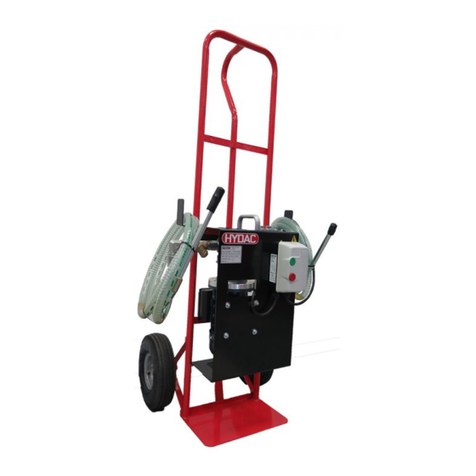
HYDAC International
HYDAC International OFT20 Operating and maintenance instructions

Pool Technologie
Pool Technologie JUSTSALT UNO user manual
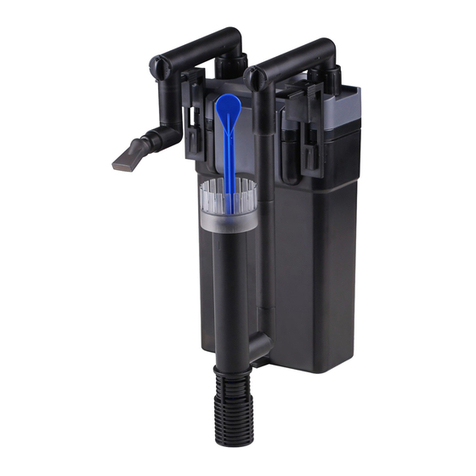
SunSun
SunSun HBL-801 operating manual
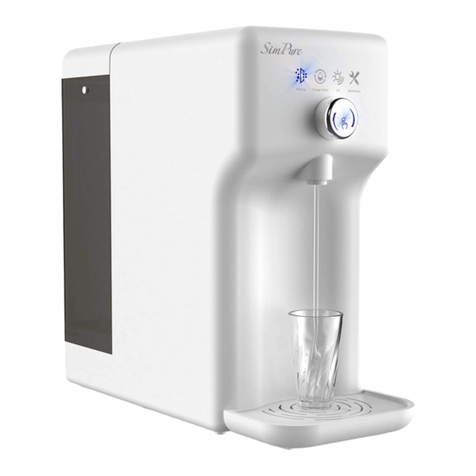
SimPure
SimPure Y6 Operator and maintenance manual
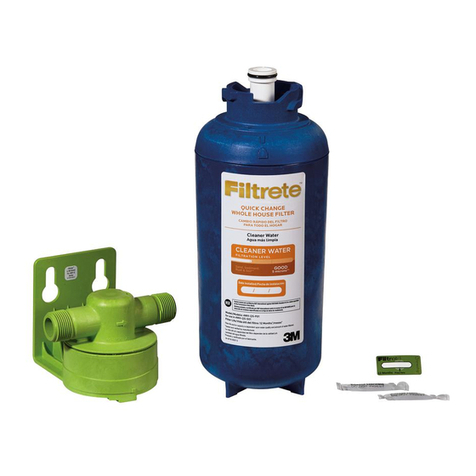
3M
3M Filtrete 4WH-QS-S01 Installation and operating instructions

WaterLogic
WaterLogic WL3 FX manual
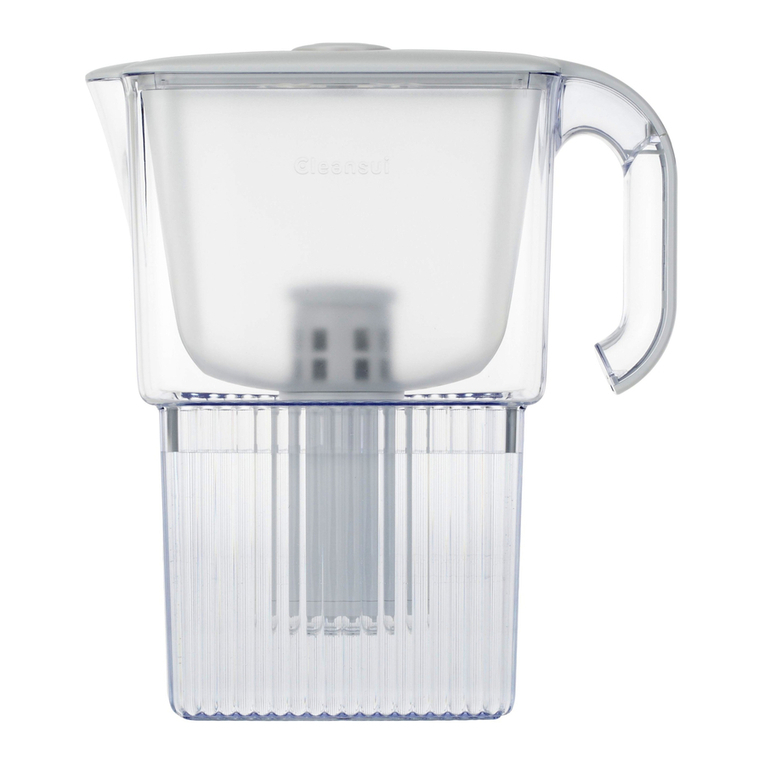
cleansui
cleansui CP305E instruction manual
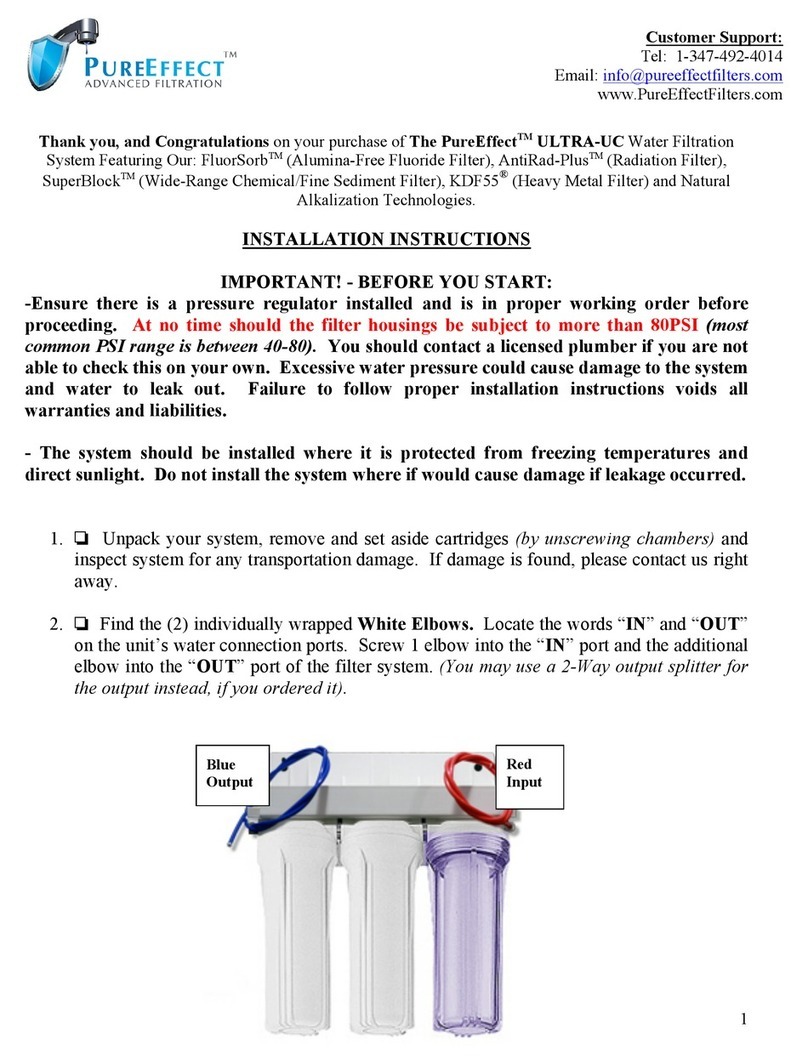
PureEffect
PureEffect ULTRA-UC installation instructions
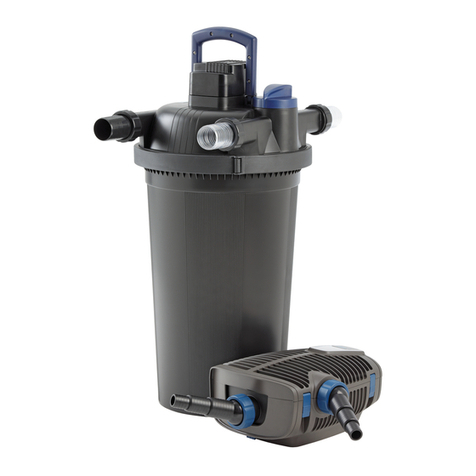
Oase
Oase FiltoClear 20000 operating instructions

Premier
Premier 500320 UV-3 Installation, operation and maintenance manual

